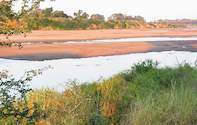
South African National Parks and the South African Environmental Observation Network (SAEON) in conjunction with the Kruger Park Marathon Club hosted the 4th annual KNP Science Networking Meeting in Skukuza from March 13 to 17.
The meeting originated in April 2002 when 115 ecologists gathered from all over the world at Berg en Dal to discuss the material that was to be published in The Kruger Experience edited by Du Toit, Rogers and Biggs (2003). Both Rogers and Biggs were present again this year.
The theme for this year's meeting was "Understanding the future". The purpose of the annual meeting is to bring together all those directly involved in current research within the Park in an atmosphere that promotes feedback, collaboration and the forging of partnerships. The presenters are each given 10-15 minutes to present a summary of their current or proposed research activities.
Meals provide the opportunity for the informal exchange of comments, ideas, suggestions as well as catching up with colleagues from all over the world who might otherwise be at the other end of the email network.
200 Delegates
Dave Balfour of the Phalaborwa based Ndlovu Node of SAEON welcomed the delegates before handing over to Bandile Mkhize, chief executive officer of KNP who officially opened the proceedings. Dr Mkhize emphasised the contribution the Park's Scientific Services has made to conservation in South Africa and the world since its inception in 1950.
He suggested that with over 200 registered delegates, the Networking Meeting has now become the largest gathering of ecologists in the country. Together they represent over 160 active research projects with 380 participants, 70 percent of whom are from overseas. A healthy balance of 26 local and 30 international institutions attract top quality researchers and expose KNP to cutting edge science whilst encouraging local capacity building.
Sanparks sees its role as an "integrator, driver and coordinator of the research effort required to provide the most up to date information it requires to adaptively manage the Park according to its stated objectives". These objectives allow Sanparks to live up to its mission statement of maintaining biodiversity in all its natural facets and fluxes whilst providing human benefits in a manner detracting as little as possible from the wilderness qualities of the Kruger National Park.Bob Scholes of the Council for Scientific and Industrial Research presented the keynote address intended to set the tone for the presentations to come. He discussed the implications of the anticipated Lowveld climate changes with special reference to the tree:grass ratio and its consequent effect on the biodiversity of the region.He concluded that the key to the response of the ecosystem will be in the management of the ecosystem for reduced vulnerability to provide robustness for different futures. This will require radical changes in the current philosophy of conservation and will have to include establishment of social, governance and economic mechanisms to support biodiversity.
85 Presentations Over Three And A Half Days
A total of 85 presentations and 20 posters covering a broad range of topics relevant to the Kruger National Park and its management were squeezed into15 themed sessions over the following three and a half days. The sessions on Long Term Data and its Management covered issues around the collection, storage, relevance and usage of information from both short and long term studies.
This information is used in establishing and monitoring the Thresholds of Potential Concern around which the KNP's management protocol is based. Species specific topics such as bovine TB in buffalo, lion diet and movement patterns, how herbivores interact with their environment and some of the ecological issues surrounding elephants were presented as part of the mammalian studies session.
General ecological studies covering landscape associations and functions including the influences of fire and water on the chemical and physical environment and its biodiversity were also discussed. One session was devoted to the invasion of exotic species such as water hyacinth and fungal pathogens.
The final half day saw presentations by the socio-ecologists covering topics concerning local communities and their role in conservation into the future, animal-human conflicts, the use and value of natural resources to those living on the borders of Kruger and the preservation of cultural heritage in KNP.
The general consensus of the delegates was overwhelmingly positive with many vowing to come again for as long as they are associated with the KNP and are invited. Highlights for attendees varied from the excellent dinner social sponsored by the Mellon Foundation, the heated "debates" and stimulating conversation to the mere fact that it takes place in one of the largest conservation areas in Africa. As a result of this enthusiasm the meeting is outgrowing the facilities available in Skukuza and the question is being raised about moving it to another location within Kruger.
By Craig Ferguson

